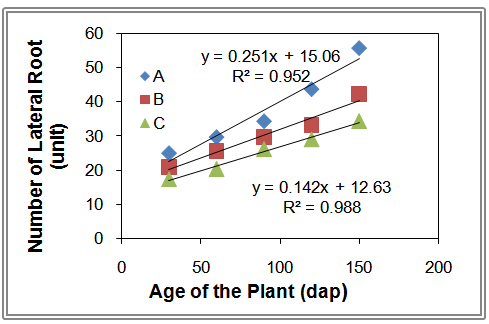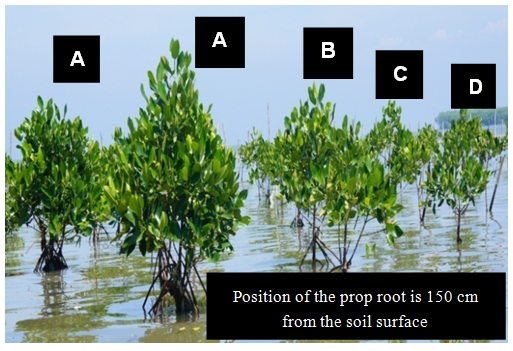-
Paper Information
- Next Paper
- Paper Submission
-
Journal Information
- About This Journal
- Editorial Board
- Current Issue
- Archive
- Author Guidelines
- Contact Us
International Journal of Ecosystem
p-ISSN: 2165-8889 e-ISSN: 2165-8919
2014; 4(5): 203-211
doi:10.5923/j.ije.20140405.01
Modification on Shape and Inner Layer Material of Bamboo Basket Towards the Growth of Mangrove Rhizophora mucronata Lamk in Wavy and Deep Watery Site
Ratna Rositawati1, A. Suryanto2, Soemarno3, Syamsulbahri2
1Doctoral Program of Agricultural Sciences, Faculty of Agriculture, University of Brawijaya, Indonesia
2Department of Crop Production, Faculty of Agriculture, University of Brawijaya, Indonesia
3Department of Soil Sciences, Faculty of Agriculture, University of Brawijaya, Indonesia
Correspondence to: Ratna Rositawati, Doctoral Program of Agricultural Sciences, Faculty of Agriculture, University of Brawijaya, Indonesia.
| Email: |  |
Copyright © 2014 Scientific & Academic Publishing. All Rights Reserved.
Objectives of the research are to obtain combination of the suitable shape of bamboo basketwith its inner layer materials, in improving growth of Rhizophora mucronata seedlings and triggering the emergence of roots. The field research was done at the mangrove tourism area of Wonorejo, Surabaya, Indonesia, for six months from August 2012 to January 2013. The research used Randomized Complete Design along with nine combinations of treatment by three replications. Treatment of the bamboo basket comprises of three shapes, such as Round, Glass Foot, and Bottleneck; meanwhile, the inner layer material comprises of three types, such as coconut fibre, gunny sack, and banana bunch. Moreover, there are nine treatments that include A. Bottleneck with Coconut Fiber, B. Bottleneck with Gunny Sack, C. Bottleneck with Stem of Banana Bunch, D. Round Shape with Coconut Fiber, E. Round Shape with Gunny Sack, F. Round Shape with Stem of Banana Bunch, G. Glass Foot with Coconut Fiber, H. Glass Foot with Gunny Sack, I. Glass Foot with Stem of Banana Bunch. Each of the experiment unit comprises of 35 plants, so that there are 9 x 3 x 35 plants = 945 experimental plants, with the control without bamboo basket is about 100 plants. Parameters of the observation include plant height, number of leaf, leaf area, fresh and dry weights of the plant, root length, number of lateral roots, volume of the roots, fresh and dry weight of the roots. However, based on modification of the bamboo basket and the inner layer, the Bottleneck shape of bamboo basketwith its inner layer of coconut fiber has provided the best result by the increasing percentage of life 100% and accelerating the growth of R. mucronata roots for 150 dap (day after planting), dry weight of the plant increases 87.74 g/plant and height of the plant is 118.08 cm.
Keywords: Rhizopora, Bamboo basket
Cite this paper: Ratna Rositawati, A. Suryanto, Soemarno, Syamsulbahri, Modification on Shape and Inner Layer Material of Bamboo Basket Towards the Growth of Mangrove Rhizophora mucronata Lamk in Wavy and Deep Watery Site, International Journal of Ecosystem, Vol. 4 No. 5, 2014, pp. 203-211. doi: 10.5923/j.ije.20140405.01.
Article Outline
1. Introduction
- Areas that have extreme high and fall tides patterns should not implement the conventional planting, by embedding the seedlings and tied them up to the stake, but applying the modification of seedling system in polybags of bamboo that are made in special design by sharpening the bottom part as peg to enforce the seedlings along with tied up on the stake to strengthen the seedling (Nontji, 1987). Moreover, Poedjirahajoe (1996) suggested that direct planting has lower level to survive for about 20-30%. It is due to the effect of high and fall tides flows, as well as predator; meanwhile, the seedling system has relatively high survival that ranges 60-80%; however, experience in the field has proven that the survival level using propagule and varying seeds of mangrove and it dependes on condition of the area. Ecosystem of the mangrove plays multifunctional roles, such as physical roles that could control abrasion, sea water intrusion to the plain and could sustain the waste from the plain, which is controlled by the rooting system. Other function is as protector of the coast border in order to hold back the waves and slow down the flows of high and fall tides. The physical environment control can be done by increasing quality of the habitat and returning quality of the green area through reforestation by developing the suitable plants and relating to the food sources of the wild life or as habitat of its environment (Nirarita et al., 1996). Failure in mangrove rehabilitation is caused by the great waves as serious obstacles, particularly at the specific sites; therefore, it requires suitable technology that will be able to support the stand of mangrove to grow well. Kusmana et al. (2009) has developed a planting technique using guludan method for about 60 guludan, but 25 guludan has poor effect on the mangrove growth, therefore it should be completed in order to provide optimal influence for the mangrove growth, before a technology would be socialized, widely spread to the public. Continual research by Kusuma (2010) has completed the planting technique by guludan method and showed the growth percentage of the R. mucronata and Avicennia marina for about 100% by average diameter of the species are 24.49-24.69 mm and 9.15-9.86 mm, respectively; while the average plant heights are 116.63-121.31 cm and 86.53-103.07 cm, respectively. Many efforts to restore the damages of the mangrove forest area and diverse research in Indonesia have been done but they have not shown any success. Particularly in mangrove’s planting techniques and methods at the field that have not found the appropriate pattern, besides some obstacles as the inhibiting factors, such as planting the unsuitable plants, which not conform to the real condition where the plants grow, and the proliferation pattern that is still natural and seedling availability, which still depends on the season. Method of such bamboo basket, which mostly used to grow the cylindric mangrove of ± 40 cm in diameter and 1.00 meter in height, is covered by plastic sack. The shape of such bamboo basket should be improved and completed in order to be used optimally due to the diameter is big enough and requires more soil medium, whereas the soil availability as growing medium is limited and the plastic sacks as the layer material could pollute the environment. Therefore, a modification of bamboo basket shape with material that hospitable to environment is required, so that this method can be used optimally. Planting Sonneratia caseolaris Linn at the Mangrove area in Muara Angke DKI Jakarta, by spacing 1 x 1 m that results percentage of the growth 70 % after 6 months, 60% after 1 year and remains 18% after 6 years due to the growth competition among plants in obtaining nutrients and the growing space (Santoso et al., 2007).Research by Handayani and Priyanto (2010) have improved modification of the planting techniques using wrapped pipe of 5 cm in diameter, but it failed, and then replaced by other wrapped pipe of 10 cm in diameter. The wrapped pipes are tied up to an intact bamboo (stake/marker), which is embedded in 1 meter depth of the water and such modification of the planting techniques has given opportunity for the mangrove seeds to grow and not drifted away by the flows. Nevertheless, the mangrove grows slowly, so that it requires maintenance, watering, controlling the diseases/pests, and embroidering in dry season.Rhizophora is one of genus, besides Avicennia and Sonneratia, which can be applied to restore the ecology in Indonesia due to its ability to stabilize muddy sediment through the extensive rooting system. Rhizophora sp. grows dominantly along the east coast of Surabaya. Height of the Rhizophora sp. will be able to reach 30 meter in good habitat, muddy and soft soil, as well as grow well at the estuary area of the river. Besides that, Rhizophora sp can be tolerant to sandy and muddy soil in the submerged condition by the frequency of 20-40 times/month (Dahdouh-Guebas F. 2005; Kitamura et. al., 2003; Herdiana. 2008).Success and failure in planting mangrove at the mangrove forest area are higly determined by condition of the real sites and the planting techniques, because not all areas are ideal to grow the mangrove. The sites should have specific characteristics; therefore an innovation of technology is required to preserve the plant survival in such sites. The specific characteristics include: site that has strong wave/flows, in general, it can be handled by establishing the breakwater, and in the submerged site, it can be handled by establishing buffer rods and planting the plant in bambbo basket, in deep muddy and watery sites (Kusmana, 2010). Besides lack of planting technique/process of mangrove for specific sites, therefore, rehabilitation on the mangrove area is difficult to be implemented.
2. Research Methods
2.1. Study Site
- The research was done at the wavy and deep watery site (the outer zone that is adjacent to the sea) at the Mangrove Tourism Area of Wonorejo, Surabaya. The planting location has diurnal high and fall tides, once high tide and once fall tide. The research was performed for 6 months from August 2012 to January 2013.
2.2. Instruments and Materials
- Instruments of the research include axe, hoe, tape measure, ropes that made of bamboo, plastic pail, scissors, and knife. Materials of the research include muddy medium that derived from habitat where the mangrove grow, R. mucronata seedlings at 4 months age, 4 leaves from the seedling by propagule length of 45 cm in polybag, by the medium proportion for muddy soil and stable manure 1 : 1.
2.3. Procedure of the Implementation
- The research used Randomized Complete Design along with nine combinations of treatment by three replications. Treatment of the bamboo basket comprises of three shapes, such as Round, Glass Foot, and Bottleneck; meanwhile, the inner layer material comprises of three types, such as coconut fiber, gunny sack, and banana bunch, so that there are nine treatments that include A. Bottleneck with Coconut Fiber, B. Bottleneck with Gunny Sack, C. Bottleneck with Stem of Banana Bunch, D. Round Shape with Coconut Fiber, E. Round Shape with Gunny Sack, F. Round Shape with Stem of Banana Bunch, G. Glass Foot with Coconut Fiber, H. Glass Foot with Gunny Sack, I. Glass Foot with Stem of Banana Bunch. Each of the experiment unit comprises of 35 plants, so that there are 9 x 3 x 35 plants = 945 experimental plants, with the controls without bamboo basket are about 100 plants. The research was done by applying modification of bamboo basket in three shapes, i.e. Round, Glass Foot, and Bottleneck. The glass foot is the reverse shape of bottleneck. Providing Round Bamboo Basket by the volume (25 cm in diameter x 80 cm height), providing modifications of Glass Foot, 25 cm in diameter of the top part, 80 cm in height, and 15 cm in diameter at the base part; for the Bottleneck, the measurement is similar, but reversed. The peg as reinforcer of the bamboo basket by 10 cm in width and 150 cm in length, 4 pegs per bamboo basket (coconut fibre, gunny sack, and stem of the banana bunch) in accordance with the treatment, as presented in Figure 1. The seedling of R. mucronata, at the age of 120 days, was taken from the seedbed, which having 4 leaves in uniform condition with the initial length of propagule 45 cm and the medium proportion between muddy soil and the stable manure is 1: 1 (50%).Installation of the bamboo baskets and pegs were done simultaneously during the fall tides by establishing measurement of the planting area restriction using raffia fibre in accordance with the ground plan (sketch) of the experiment. Installation of the bamboo baskets was done randomly according to the treatment, nine combinations of the bamboo basket shapes and inner layer materials. After all bamboo baskets were installed with four pegs, and then filled with the planting medium by the same volume, 8 kg/bamboo basket, so that the medium height in the bamboo basket is different one to another (height of the medium in the Round shape is 42 cm, Glass Foot is 77 cm, and Bottleneck is 73 cm), and followed by the planting process of R. mucronata seedlings in the bamboo basket in 20 cm depth from the medium surface and installation of the bamboo stake with 2 cm in thickness and 100 cm in height, tying up the stem of the mangrove seedling on the stake using fibrous rope, so that the mangrove could stand in the middle of the medium. Planting the seedling of R. mucronata as the control without bamboo basket, for about 100 seedlings, was done inter-bamboo baskets; mean while, for observation on percentage of the growth, ten plants each has been prepared for each treatment by three replications, so that there are 270 plants in the bamboo basket. Routine maintenance through watering should be done, if necessary, as well as embroidering, just in case of any dead plants were found, which is restricted to two weeks after planting and examine condition of the plants once a week to control the tritip (maggot) or crabs, which could damage the plants. Observation on variable of the growth can be done by observing organs of the plants non destructively when the plants reach the age of 30, 60, 90, 120, and 150 dap (days after planting). Particularly, observation on percentage of life, which were observed on nine treatments of bamboo baskets that comprised of 10 plants for each treatment by three replications that would be done when the age of the plant reach 24 months after planting.
2.4. Observation
- The destructive observation is an observation that pulling out the plants at the age of 30, 60, 90, 120 and 150 days after planting (dap) that include: Plant length t0 is counted from the stem at the soil surface (marked) to the tip of the observed plant, once in 30 days. The increasing number of leaves is counted for each plant (count all leaves that have completely opened and subtracted by numbers of leaf before planting). Leaf area is measured using Leaf Area Meter (LAM) of Licor L1 3100 C. The increasing stem diameter, measuring the stem circumference of the mangrove using sliding calipers and stem diameter, which is measured 10 cm from the soil surface, number of lateral roots, prop roots, root length, roots volume, dry weight of the roots, fresh weight of the roots. Number of lateral roots are counted from newly grown roots, the root length is measured from the root base of the top part to the tip part of the roots, and observation will be ended if the prop roots have emerged, the root volume is measured by cutting all the roots into small pieces and then put them into a 1,000 ml calibrated beaker, which has been filled with water in a given volume. The roots volume is the extent of increasing water volume in the calibrated beaker from the former volume. Fresh Weight and Dry Weight of the Plants are fresh material of the plants, which are dried using oven at 65-85℃. In particular, observation on percentage of life will be observed after the age of the pants reach 24 months after planting, in March 2013.
2.5. Data Analysis
- Data on result of the observation by gauge parameter has followed the analysis of variance (ANOVAs) at level 5% to study the effect of treatment. If any significant effect existed on the treatment, it must be tested using the Smallest Significant Difference (SSD) at the level 5% (Gomez and Gomez, 1995).
3. Result and Discussion
3.1. Result
- From combination of the bamboo basket in Round, Glass Fott, and Bottleneck shapes with three inner layer materials, such as coconut fibre, gunny sack, and stem of the banana bunch, it shows that treatment using the combination of Bottleneck and coconut fibre (A) has provided suitable condition that will increase the growth in comparison with other treatments. Results of the observation based on combination of Bottleneck with three inner layer materials, such as coconut fibre, gunny sack, and stem of the banana bunch, as follow: Treatment using Bottleneck shape with three inner layers, such as coconut fibre, gunny sack, and stem of banana bunch, has shown linear growth pattern, in which the highest growth for the plant height has occurred in R. mucronata that are planted in Bottleneck with coconut fibre, which having linear growth (y = 0.137 x + 98.072 by R2 = 0.98). Coefficient values of the determination (R2) describe the extent of X effect (age of the plant) on Y (height of the plant), and result of the calculation gives R2 =0.98, it means that 98.0% of the increasing height of the plant will be followed by the age of plant, as presented in Figure 1.
 | Figure 1. The Growth Pattern of the Plant Height in R. mucronata at 30 dap to 150 dap. Treatment using Bottleneck with Coconut Fibre (SK), Gunny Sack (KG), and Stem of the Banana Bunch (PP) |
 | Figure 2. The Growth Pattern of the Leaf Area in R. mucronata at 30 dap to 150 dap. Treatment using Bottleneck with Coconut Fibre (SK), Gunny Sack (KG), and Stem of the Banana Bunch (PP) |
 | Figure 4. The Growth Pattern of the Root Volume in R. mucronata at 30 dap to 150 dap. Treatment using Bottleneck with Coconut Fibre (SK), Gunny Sack (KG), and Stem of the Banana Bunch (PP) |
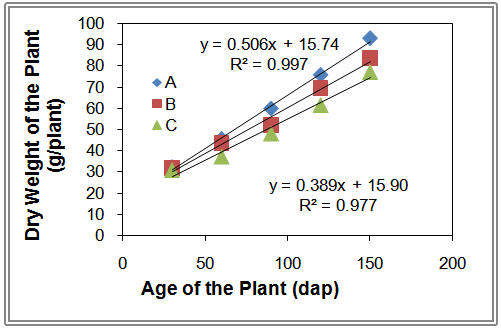 | Figure 5. The Growth Pattern of the Plant’s Dry Weight in R. mucronata at 30 dap to 150 dap. Treatment using Bottleneck with Coconut Fibre (SK), Gunny Sack (KG), and Stem of the Banana Bunch (PP) |
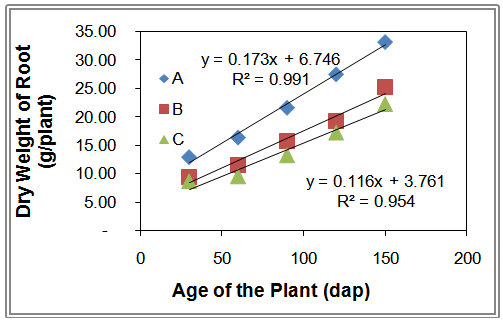 | Figure 6. The Growth Pattern of the Seedling’s Dry Weight in R. mucronata at 30 dap to 150 dap. Treatment using Bottleneck with Coconut Fibre (SK), Gunny Sack (KG), and Stem of the Banana Bunch (PP) |
3.2. Discussion
- In wavy and deep watery sites, the growth of R. mucronata seedlings are highly affected by substrates and organic materials as well as nutrients derived from the soil and land, which has been drifted away by the river flows during high and fall tides, are considered as very important factors in supporting growth of the plants (Fauziah et al., 2004); El-Khouly et al., 2007). It is suggested for areas, which have such extreme pattern of high and fall tides, should not apply the conventional planting pattern because the seeds would be easily drifted away or removed by the waves due to they are just tied up into the stake. However, such pattern has still been applied at present even the growth has not optimal and more seeds have removed uselessly. According to Kesemat (2008), at the age of 0 to 3 months after planting, the mangrove seedlings would have such critical phase during the growth. 80% of the whole seeds have survived, and the rest died. The death of mangrove is caused by some factors, such as: drifted away by the flows, submerged water that causes rotten stems, the infection of pest, for instance, tritip (maggot), and covered by wastes. In a very extreme pattern of high and fall tides, the planting technique should be applied on specific planting sites, and one of them is using bamboo basket, which requires the shape modification in order to achieve optimal outcomes, increasing the growth and accelerating the growth of the prop roots. More benefits will be obtained by applying such method, not only affect the growth of the plants or increase the growth percentage, but also sustain from both high and fall tide flows, so that the plants would not easily collapsed and drifted away, as well as muddy material that is taken along with the waves and come into the bamboo basket. Besides that, such bamboo basket method could protect the young mangrove from specific pests, such as tritip (maggot) and crabs.
3.2.1. Types of Inner Layer Material of the Bamboo Basket
- Materials for inner layer of the bamboo basket should be selected from organic materials, which would not pollute the environment. The materials include coconut fiber, gunny sack, and stem of banana bunch (stem sheath) that can be used to prevent the medium of being released from the bamboo basket. Besides that, during the growing process, the roots of R. mucronata are susceptible to damages due to highly extreme environmental factors, therefore, the coconut fiber, gunny sack, and the stem of banana bunch could protect the growth of rooting system in order not to be easily damaged by the waves because the newly grown roots are easily broken (Purnobasuki and Suzuki. 2005). The analysis result of the laboratory at the Laboratory of Soil Biology in Faculty of Agriculture, University of Brawijaya, and the stem of the banana bunch has coarse fiber 57.02% lower than using gunny sack and coconut fiber, which have 85.47% and 65.35%, respectively. This causes layer of the stem of banana bunch will be easily shattered and no longer sustain the soil medium inside the bamboo basket, while the newly grown roots are susceptible to be destroyed during the growth process due to such extreme environmental factors, such as waves, strong wind, and pest infection, which could disturb stability at the rooting growth zone. However, the coconut fiber has porous surface, so that the newly grown roots would easily permeate and bind to the layer than the smooth surface of the gunny sack. Besides that, excessive layers in the bamboo basket with the coconut fiber may have higher air permeability than the gunny sack and the stem of banana bunch, 8.683 x 10-13m3.m-1. Higher air permeability makes the use of coconut fiber could supply oxygen when the plants are not submerged, then the available oxygen will be stored in rooting system as reserves that will produce higher energy for the rooting growth. The oxygen reverses will be used for respiration process when the roots are submerged, so that the plant will be survived. Therefore, Bottleneck treatment by coconut fiber as the inner layer would produce higher volume of roots than the other treatments, 51.67 cm3.
3.2.2. The Shape of Bamboo Basket
- In fact, the bamboo basket shapes affect the success in growing due to different shapes of bamboo basket affect the growing space volume of the rooting system as shown in different height of the planting medium, which have the same weight. Bottleneck has rooting growth space, which is tightened at the top part, and it will restrict the growth of lateral roots. The restricted growth of lateral roots in the neck zone of the bronjong will trigger the prop roots growth above the neck, above the substrate/medium at 150 daps. The prop roots have lenticels (aerial holes), which absorb nutrients to support the plant growth, (Ananda, Sridhar, Raviraja and Bärlocher, 2008). It can be proved that treatment by Bottleneck along with the coconut fiber have higher height, leaf area, and dry weight than other treatments. The modification of bamboo basket shapes, such as Round, Bottleneck, and Glass Foot, have affected the success in growing the R. mucronata seedlings, due to different shapes of bamboo basket have affected volume of the growing space of the rooting system as shown in different height of the planting medium, which have the same weight. Round shape, which has been filled with planting medium, is measured from the bamboo basket’s base in which the medium height is 42 cm, 73 cm for Bottleneck, and 77 cm for the Glass Foot. Bottleneck has rooting growth space, which is tightened at the top part, and it will restrict the growth of lateral roots. The restricted growth of lateral roots in the neck zone of the Bottleneck shape will trigger the prop roots growth above the neck, above the growing substrate/medium at 150 daps. The growth of prop roots will be followed by the increasing volume of the roots. It can be proved on the treatment of Bottleneck shape with the coconut fiber, which has higher height, leaf area, and dry weight than other treatments (Figure 7).
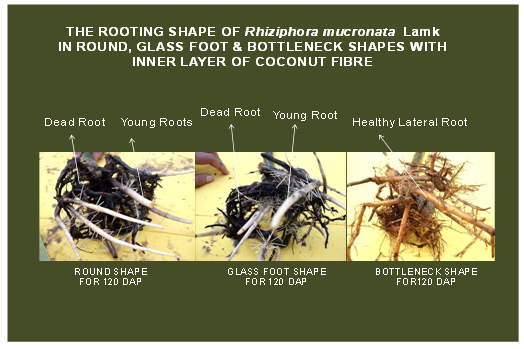 | Figure 7. The Rooting Shape of R. mucronata in Round, Glass Foot and Bottleneck Shapes with Inner Layer of Coconut Fibre at 120 dap |
 | Figure 8. Modification on Shapes of Round, Glass Foot, and Bottleneck |
3.2.3. The Emergence of Rhizophora mucronata Roots
- In supporting the success of rehabilitation in growing mangrove seeds, particularly R. mucronata, it requires some efforts that could accelerate the growth of prop roots, because the functional development of the lateral roots would be reduced. During the growth and development phase, number of the prop roots will keep increasing due to in mature phase, these prop roots will play dominant roles as absorptive roots to absorb nutrients and the anchor roots to transport the incoming air through lenticels for respiration of the plant. The prop roots are so-called as aerial roots, which grow above the soil surface, spring back from the stem and lower branches of the plant and extended, come out from the soil surface and support the stem (Nirarita, 1996, Kitamura, 1997). According to Dahlan, Sarno, and Ali (2009), the prospective prop roots of the Rhizophora apiculate could be able to observed naturally or found at the age of 1-2 years and still in growing process, during the Juvenile phase with positive geothropic response. The prop roots are also useful as a tool to compete in gaining space and shield of defence against the extreme environmental condition as well as to sustain in its habitat. The modification of planting method using bamboo basket in diverse shapes, such as Bottleneck, along with inner layer of coconut fiber, will accelerate the emergence of prop roots. However, in normal and natural planting, new prop roots can be observed for one to two years after planting. The prop roots of Rhizophora is an adaptation of tree to its environment, under unaerob (low level of the oxygen) condition of the environment, so that this plant has aerial roots that is equipped with lenticels (aerial pores) to gain oxygen from the air, Roots above the soil surface have many small pores on the bark, where the oxygen could pass through and transported to the entire rooting system in the soil. Such aerial roots may grow upside down, from the stem or lower branches, covered by wax layer that can be passed by the oxygen, but cannot be penetrated by water. Percentage of life and growth of R. mucronata using bamboo basket without sorting the applied basket shapes (Round, Bottleneck, and Glass Foot) at the end of observation at 150 dap, among 270 R. mucronata, which are grown in basket and in wavy-watery sites, they grow well and reach 3.0 meter height in which more prop roots have grown at the third part of the plant for 630 dap in January 2014. While the control treatment without basket, out of 100 plants during the last observation at 150 daps, only three plants have remained and grown poorly. During the growth and development phase of the roots, the increasing volume and dry weight of the roots, which are grown in Bottleneck shape with coconut fibers (A) show higher, 51.67 cm3 and 33.26 gram/plant during the observation at 150 dap in comparison with other treatments and have higher roots distribution following the increased number of lateral roots, 55.67 stems higher than other treatments, and it will increase the extent of nutrient absorption that will support the plant growth. The shape of Bottleneck has rooting space, which is tightened at the top part, and of course, it will restrict the growth of lateral roots. The restricted growth of lateral roots in the neck zone of the Bottleneck shape will trigger the prop roots growth above the neck, above the substrate/medium at 150 daps. The growth of such prop roots will be followed by the increasing volume of the roots. It has been proven by the shape of Bottleneck with inner layer of coconut fibers, in which the plant height, leaf area and dry weight of the plants are higher than other treatment. The prop roots are so-called as aerial roots, which grow above the soil surface, spring back from the stem and lower branches of the plant and extended, come out from the soil surface and support the stem. The prop roots of Rhizophora are an adaptation of tree to its environment, under anaerobe (low level of the oxygen) condition of the environment. So that this plant has aerial roots which is equipped with lenticels (aerial pores) to gain oxygen from the air. Roots above the soil surface have many small pores on the bark, where the oxygen could pass through and transported to the entire rooting system in the soil. Such aerial roots may grow upside down, from the stem or lower branches, covered by wax layer that can be passed by the oxygen, but cannot be penetrated by water (Nirarita, 1996, Kitamura, 1997, Halidah. 2010). According to Dahlan et al., (2009), the prospective prop roots of the Rhizophora apiculata could be able to observed naturally or found at the age of 1-2 years and still in growing process, during the Juvenile phase with positive geotropic response. The prop roots are also useful as a tool to compete in gaining space and shield of defense against the extreme environmental condition as well as to sustain in its habitat. The modification of planting method using bamboo basket in diverse shapes, such as Bottleneck with inner layer of coconut fiber will accelerate the emergence of prop roots. The existing prop roots to transport the incoming air through lenticels by gas exchange process can be used by the plants for respiration. If the entire lenticels in roots are covered by muddy or high tide, O2 in the substrate will reduce and CO2 increases, and anaerobe condition occurs (Catherine et al., 2006). Lenticels in the prop roots could increase O2 exchange, which is required for the roots growth in submerged condition. Permeability of oxygen to the roots is very important for growth and nutrient absorption due to low oxygen in the environment. High air permeability in the coconut fiber would facilitate the oxygen exchange or oxygen intake from the air by the plant, which is not in submerged condition. Then, oxygen will be stored as air reserves within the plant tissues for root respiration under water stress. Besides that, tight layer of the coconut fiber could support the roots growth stability in the rooting zone (Figure 9).
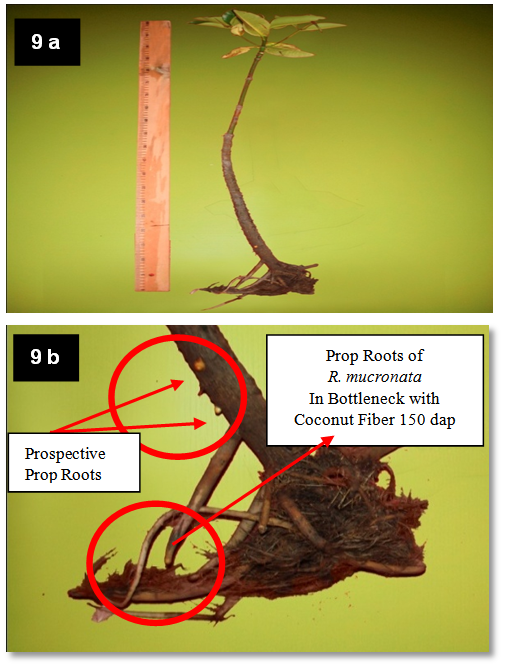 | Figure 9. The plant of Rhizophora mucronata (a) and The Emergence of Prop Roots and Prospective Prop Roots (b) in Modification of Bottleneck Shape by Inner Layer of Coconut Fiber at 150 dap |
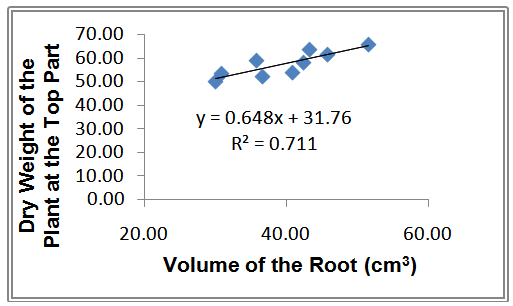 | Figure 10. Relationship between Volume of the Roots and Dry Weight at the Top Part |
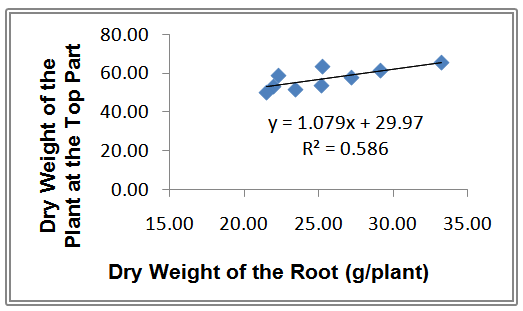 | Figure 11. Relationship between Dry Weight of Roots and Dry Weight of Plant at the Top Part |
3.2.4. Percentage of Life on Rhizophora mucronata by The Age of 24 Months after Planting
- During the observation on life percentage after the age of the plant has reached 24 months after planting, on 9 treatments that comprise of 30 plants each. Among 270 plants that have been observed for the Bottleneck with coconut fiber, Bottleneck with gunny sack, Round shape with coconut fiber, and Glass Foot with coconut fiber that have life percentage 100% by different growth as presented in Figure 12 and 13.
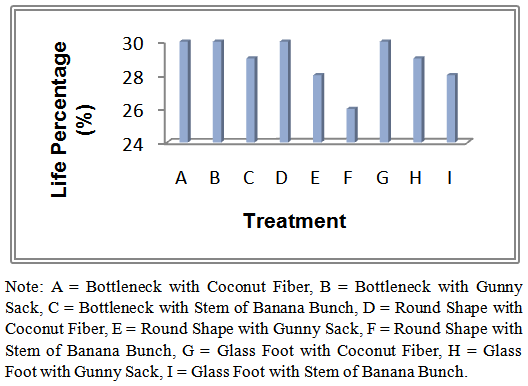 | Figure 12. Histogram of Life Percentage of Rhizophora mucronata Seedlings for 24 months after planting. Treatment of the Bamboo Basket Shape and Types of Inner Layer Material |
4. Conclusions
- Modification of planting method using bamboo basket by combination of the Bottleneck with the inner layer of coconut fiber has provided the best yield and could accelerate the growth of prop roots of R. mucronata for 150 dap (days after planting), by percentage of life 100%, dry weight of the plant is 92.84 gram/plant and the plant height is 118.08 cm. The prop roots of R. mucronata have emerged in 4.5 months after transplanting.
 Abstract
Abstract Reference
Reference Full-Text PDF
Full-Text PDF Full-text HTML
Full-text HTML